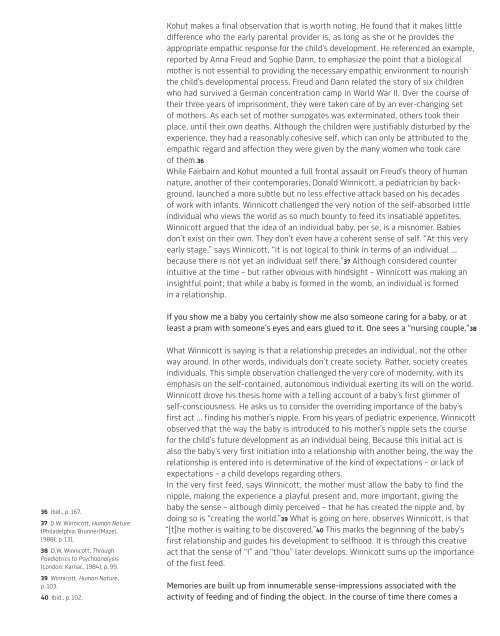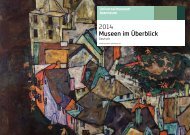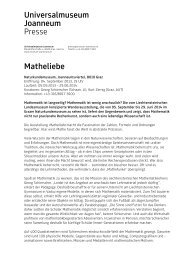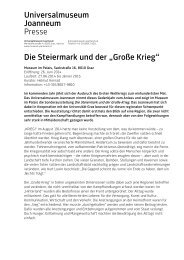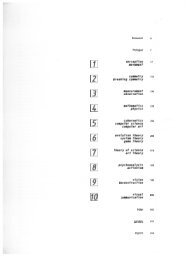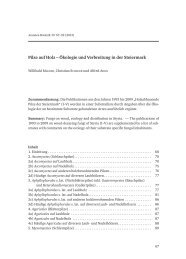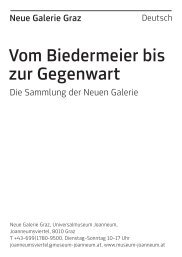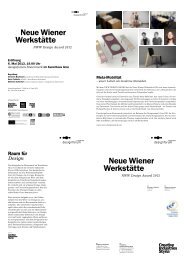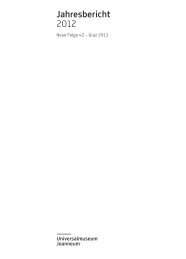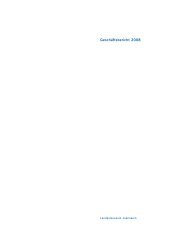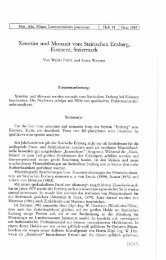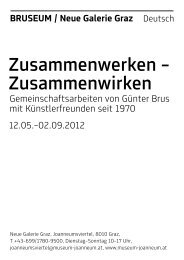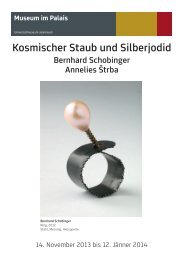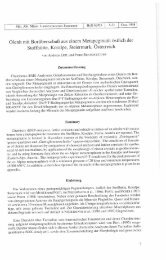Human Condition - Universalmuseum Joanneum
Human Condition - Universalmuseum Joanneum
Human Condition - Universalmuseum Joanneum
Erfolgreiche ePaper selbst erstellen
Machen Sie aus Ihren PDF Publikationen ein blätterbares Flipbook mit unserer einzigartigen Google optimierten e-Paper Software.
36 Ibid., p. 167.<br />
37 D.W. Winnicott, <strong>Human</strong> Nature<br />
(Philadelphia: Brunner/Mazel,<br />
1988), p. 131.<br />
38 D.W. Winnicott, Through<br />
Paediatrics to Psychoanalysis<br />
(London: Karnac, 1984), p. 99.<br />
39 Winnicott, <strong>Human</strong> Nature,<br />
p. 103.<br />
40 Ibid., p. 102.<br />
Kohut makes a final observation that is worth noting. He found that it makes little<br />
difference who the early parental provider is, as long as she or he provides the<br />
appropriate empathic response for the child’s development. He referenced an example,<br />
reported by Anna Freud and Sophie Dann, to emphasize the point that a biological<br />
mother is not essential to providing the necessary empathic environment to nourish<br />
the child’s developmental process. Freud and Dann related the story of six children<br />
who had survived a German concentration camp in World War II. Over the course of<br />
their three years of imprisonment, they were taken care of by an ever-changing set<br />
of mothers. As each set of mother surrogates was exterminated, others took their<br />
place, until their own deaths. Although the children were justifiably disturbed by the<br />
experience, they had a reasonably cohesive self, which can only be attributed to the<br />
empathic regard and affection they were given by the many women who took care<br />
of them.36<br />
While Fairbairn and Kohut mounted a full frontal assault on Freud’s theory of human<br />
nature, another of their contemporaries, Donald Winnicott, a pediatrician by background,<br />
launched a more subtle but no less effective attack based on his decades<br />
of work with infants. Winnicott challenged the very notion of the self-absorbed little<br />
individual who views the world as so much bounty to feed its insatiable appetites.<br />
Winnicott argued that the idea of an individual baby, per se, is a mis nomer. Babies<br />
don’t exist on their own. They don’t even have a coher ent sense of self. “At this very<br />
early stage,” says Winnicott, “it is not logical to think in terms of an individual …<br />
because there is not yet an individual self there.”37 Although considered counter<br />
intuitive at the time – but rather obvious with hindsight – Winnicott was making an<br />
insightful point; that while a baby is formed in the womb, an individual is formed<br />
in a relationship.<br />
If you show me a baby you certainly show me also someone caring for a baby, or at<br />
least a pram with someone’s eyes and ears glued to it. One sees a “nursing couple.”38<br />
What Winnicott is saying is that a relationship precedes an indi vidual, not the other<br />
way around. In other words, individuals don’t create society. Rather, society creates<br />
individuals. This simple observa tion challenged the very core of modernity, with its<br />
emphasis on the self-contained, autonomous individual exerting its will on the world.<br />
Winnicott drove his thesis home with a telling account of a baby’s first glimmer of<br />
self-consciousness. He asks us to consider the overriding importance of the baby’s<br />
first act … finding his mother’s nipple. From his years of pediatric experience, Winnicott<br />
observed that the way the baby is introduced to his mother’s nipple sets the course<br />
for the child’s future development as an individual being. Because this initial act is<br />
also the baby’s very first initiation into a relationship with another being, the way the<br />
relationship is entered into is determinative of the kind of expec tations – or lack of<br />
expectations – a child develops regarding others.<br />
In the very first feed, says Winnicott, the mother must allow the baby to find the<br />
nipple, making the experience a playful present and, more important, giving the<br />
baby the sense – although dimly perceived – that he has created the nipple and, by<br />
doing so is “creating the world.”39 What is going on here, observes Winnicott, is that<br />
“[t]he mother is waiting to be discovered.”40 This marks the beginning of the baby’s<br />
first relationship and guides his development to selfhood. It is through this creative<br />
act that the sense of “I” and “thou” later develops. Win nicott sums up the importance<br />
of the first feed.<br />
Memories are built up from innumerable sense-impressions associated with the<br />
activity of feeding and of finding the object. In the course of time there comes a


